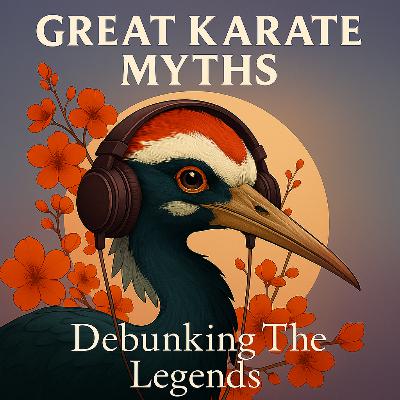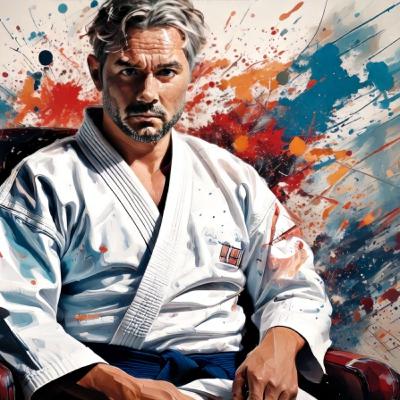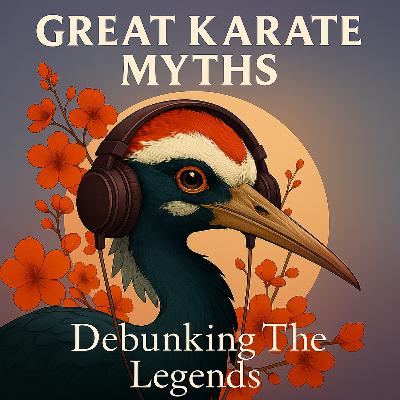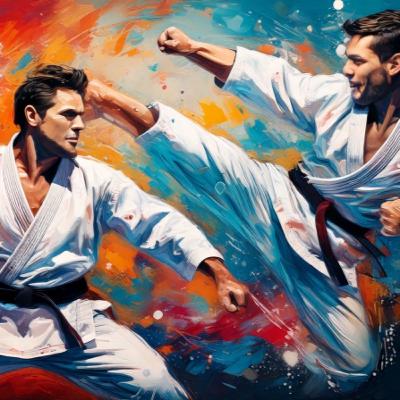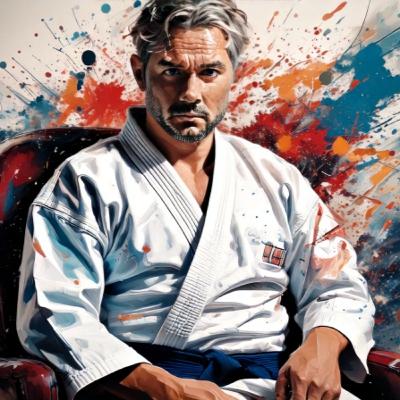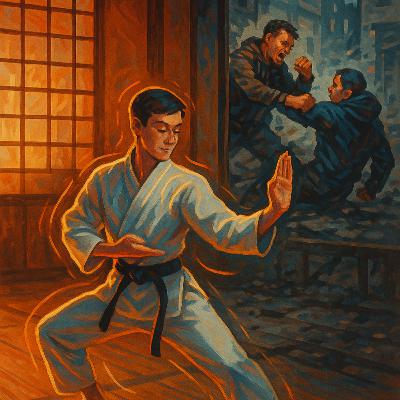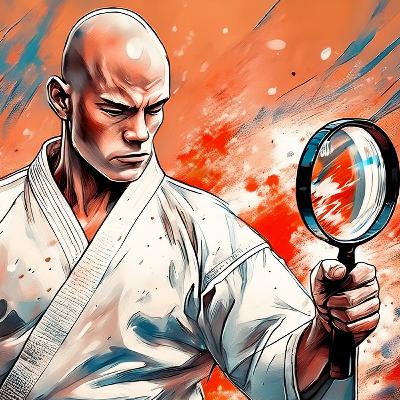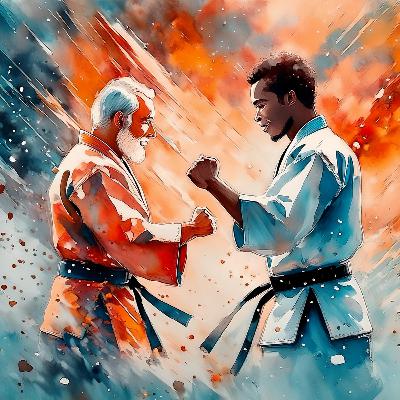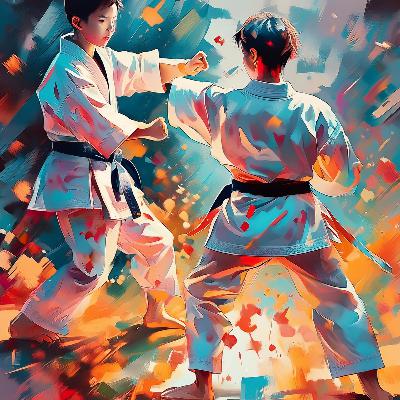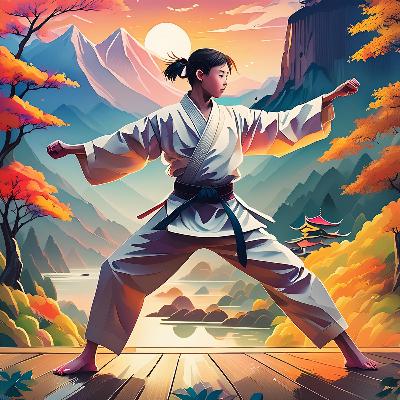Discover Great Karate Myths: Debunking the Legends
Great Karate Myths: Debunking the Legends

Great Karate Myths: Debunking the Legends
Author: Ko-do Ryu Classical Karate Association
Subscribed: 5Played: 11Subscribe
Share
© Ko-do Ryu Classical Karate Association
Description
"Great Karate Myths: Debunking the Legends" unravels the truth behind karate's most famous tales. Join our expert hosts for their insights as they dispel myths and celebrate the true spirit of this martial art. A must-listen for history and karate fans alike!
20 Episodes
Reverse
In this episode of Great Karate Myths, we dive into the aspects of martial arts that are intentionally left out of the traditional kata. We challenge the common misconceptions that kata are a "complete" system of unarmed combat or a choreographed fight against multiple opponents. We discuss why foundational elements like spitting, headbutting, and ground grappling are omitted and explore the idea that kata are meant to be a simple framework for developing spontaneous and creative skills. Using analogies from music and writing, we argue that the purpose of kata is to provide a limited, fundamental skill set that allows for improvisation, rather than a rigid set of pre-determined responses to every situation.Key Takeaways/HighlightsKata are not a "complete" system of unarmed fighting, as such a concept is impossible to define or record.Kata are not choreographed fights against multiple opponents, a major misconception promoted by organizations like the Japan Karate Association in the 20th century.Kata deliberately leave out certain violent techniques and skills, such as spitting, headbutting, eye gouging, and grappling.The movements in kata are intended to be simple, foundational techniques that can be committed to muscle memory, allowing for creativity and improvisation in real-world situations.Skills like closing the distance to an opponent are not included in kata because they must be developed through practical, real-world experience, not a pre-scripted form.
On this episode of “Great Karate Myths,” we unravel the truth behind classical karate kata. 🥋 We’re asking a controversial question: why is there no ground grappling in the antique forms? 🧐 We'll explore the life-or-death context of policing and weapon defense, and why staying upright was the only option. Discover how the modern idea of a "complete martial artist" is a far cry from the original purpose of these ancient forms. ⚔️ Get ready to challenge everything you thought you knew about martial arts history!
In this episode of Great Karate Myths, we challenge the popular belief that antique kata were designed to map out deadly vital point strikes, also known as kyusho. 🥋 We delve into historical research and explore the evidence suggesting that forms like Naihanchi and Seisan were actually developed to avoid causing serious, permanent damage. 🛡️ Instead, their purpose was likely for civil arrest and policing, focusing on techniques for disarming and incapacitating without lethal intent. 🚨 We also discuss how modern interpretations of kata, influenced by other martial arts traditions, have led to a misunderstanding of their original function. Join us as we uncover a more ethical and restrained side to the ancient practice of karate. 🙏Relevant Links/ResourcesAndreas Quast's Patreon page (for the article "How Karate Adopted Jūjutsu Vital Points Without Knowing it")Keywords/TagsKarate, Kyusho, Kata, Martial Arts, Bunkai, History, Debunking Myths, Okinawa, Antique Forms, Vital Points
In this Q&A episode, we tackle the big question: "What is the real context for karate kata?" We explore why these forms are the most credible evidence we have for understanding karate's history, and why relying solely on written historical documents is a dead end. We also delve into the surprising and diverse origins of kata, which may have included roles such as policing, bodyguarding, palace security, and even religious rituals. We discuss why specific versions of kata, particularly those in Matsubayashi Shorin-Ryu and Uechi-Ryu, are considered the best-preserved and most reliable for research. Finally, we address questions about the timeline of Sanchin and other forms, speculating on their possible Ming dynasty origins.Key Takeaways/HighlightsKata as Primary Sources: The kata themselves are the most reliable historical documents for understanding their original function and context, as written records are scarce.Diverse Original Contexts: The purpose of kata was not limited to unarmed self-defense. Their original functions likely included policing, bodyguarding, militia training, theater, and religious rituals.The Problem of Modern Kata: Many modern versions of kata, such as those in Shotokan and Wado-Ryu, have evolved and changed over time, obscuring their original meaning and making them problematic for historical research.Preserved Forms: For accurate research, it is necessary to study the best-preserved versions of kata, which are found in traditional styles like Matsubayashi Shorin-Ryu and Uechi-Ryu.Relevant Links/ResourcesBo: Techniques, Forms, and Partner Practices of Ancient Okinawan Fighting TraditionsKeywords/TagsKarate, Kata, Martial Arts History, Okinawa, Shuri, Naha, Goju-Ryu, Shotokan, Matsubayashi Shorin-Ryu, Uechi-Ryu, Sanchin, Ming Dynasty, Kung Fu, Bunkai.
In this episode of "Great Karate Myths: Debunking the Legends," we delve into Sanchin, the foundational karate kata. We explore the compelling theory that the Uechi-ryu Sanchin, brought from China by Kanbun Uechi, serves as a prototype due to its pure function for sai training. Discover how historical events, like the Qing dynasty's weapons ban, may have led to the divergence of Sanchin forms, influencing Goju-ryu's interpretation as a dynamic tension exercise without direct applications. Uncover the "map" that Sanchin provides for fundamental martial arts skills and why understanding its original purpose is crucial for unlocking its true utility. Join us for a deep dive into the evolution and enduring significance of "One Sanchin to Rule Them All."Key Takeaways/Highlights:The Sanchin preserved in Uechi-ryu is speculated to be a prototype due to its pure function and concise nature, originally intended for training with sai.The Goju-ryu Sanchin likely diverged from this common source, adapting to an empty-hand focus and leading to interpretations as a dynamic tension exercise.The historical weapons ban during the Qing dynasty may have contributed to the loss of original Sanchin functions, leading to varied interpretations and "semi-testing" practices.Core preparatory forms like Sanchin (or Naihanchi in Shorin-ryu and Sil Lim Tao in Wing Chun) are essential "maps" for developing fundamental martial arts skills.While many Sanchin forms exist, their utility for unarmed fighting or body conditioning is debated, with the Uechi-ryu version being highlighted for its clear, systematic application.References:The Great Karate Myth: https://amzn.to/4oaEiINUechi-ryu Karate Do: https://amzn.to/4l2PtAH
In this revealing episode of 'Great Karate Myths: Debunking the Legends' 🥋, we tackle the "elephant in the room" of karate: the unique and often-ignored Naihanchi fist. We challenge the pervasive notion that karate is solely about striking, arguing that the peculiar shape of the Naihanchi fist is a crucial clue to the kata's original function. 🧐Discover why this specific fist, with its top finger half-open and thumb wrapped over it, is fundamentally different from a standard punching fist. We explore how this hand shape has been overlooked in countless discussions about Naihanchi's applications, despite being clearly demonstrated in foundational texts like Gichin Funakoshi's Karatedo Kyohan. 📜We reveal that the Naihanchi fist is optimally designed for gripping and civil arrest techniques, emphasizing the physiological advantages of using the ring, middle, and little fingers for strong grip, while the index finger plays a minor role. This episode challenges the ballistic striking paradigm, suggesting that the kata's limited sideways movements and mid-level content also support a grappling interpretation. 💪🔒We also touch upon historical figures like Motobu Choki, whose "one-knuckle strike" might have been an adaptation inspired by the Naihanchi fist. This episode is a must-listen for anyone seeking a deeper, more historically accurate understanding of karate's rich and often misunderstood heritage. 🤯 delving into the past to uncover the truth!Relevant Links/Resources:Images discussed: https://www.kodoryu.com/research/naihanchiNaihanchi Grappling: https://www.youtube.com/watch?v=GJLm1OFMczAKaratedo Kyohan by Gichin Funakoshi: https://amzn.to/46SA42oThe Essence of Okinawan Karate-Do by Nagamine Shoshin: https://amzn.to/4kSYSLa
Embark on a critical exploration of Okinawan Kobudo in this episode of 'Great Karate Myths: Debunking the Legends.' We dive deep into whether modern Okinawan Kobudo is a direct continuation of ancient combative methods or a more recent development influenced by cultural demonstration and Japanese budo. Our hosts unpack the crucial differences in combat distances, discussing how antique forms, particularly with weapons like the Sai and Tonfa, emphasize extremely close-quarters engagement for maximum effectiveness, contrasting with the performative, fixed-distance choreography often seen in modern Okinawan Kobudo. Learn about key figures like Matayoshi Shinko and Taira Shinken, and how their contributions shaped the contemporary landscape of Kobudo. This episode challenges romanticized notions, encouraging a re-evaluation of how these martial arts are understood and practiced.
In this insightful episode of "Great Karate Myths: Debunking Legends," the team are joined by experienced martial arts instructor Matt Turner to challenge the common misconception that kata are perfect and provide all the answers for self-defense. They delve into the limitations of kata, arguing that they serve as fundamental "maps of the territory" and a "set of martial skills" , rather than prescriptive, scenario-based choreography.The discussion highlights how an overabundance of techniques can hinder spontaneity and improvisation in real-world altercations. Matt emphasizes that kata were not created to cover every eventuality and often originated with weapon use or defense in mind, fundamentally different from unarmed urban self-defense scenarios. The episode also touches on how the proliferation of kata and "creative interpretations" of their applications can be seen as a "currency" to attract students and generate revenue, rather than focusing on true effectiveness.Listeners will gain a deeper understanding of the historical context of kata, the importance of pragmatic application, and why continuous improvisation is paramount over rote memorization. As Matt Turner states, "They’re fundamental methods, they’re maps of the territory. And you can explore and improvise in any, you know, within those sets of skills." Key takeaways include:Kata are "maps of the territory" and fundamental skill sets, not scenario-based choreography or a "backup plan" for every self-defense situation.Too much prescriptive information or too many techniques can hinder spontaneity and the ability to improvise in an altercation.Many antique kata were designed with weapon use or defense in mind, and their application without this context often requires abandoning the original form.The proliferation and "creative interpretation" of kata have become a "currency" in modern martial arts, often detracting from the original purpose and effectiveness.Martial skills, especially those historically used by professionals like militia or palace guards, are not about perfect outcomes but about effective application by highly trained individuals.Tune in to challenge your assumptions about kata and deepen your understanding of effective martial arts training.
In this special "Question Time" episode of "Great Karate Myths: Debunking the Legends," we tackle listener questions about the true nature and purpose of karate kata. We explore the theory that kata are essentially manuals for specific weapon applications, challenging the notion that they are primary training methods. The discussion delves into historical parallels with Japanese swordsmanship and the significant impact of weapon bans in both China and Okinawa on the evolution of solo forms. We also discuss the accuracy of kata preservation and how the loss of original function led to alterations. A unique segment explores the Ko-do Ryu system's approach to holistic cultivation through physical meditation, differentiating it from other pushing hands practices. Finally, we address questions about specific kata like Passai and Kusanku and their links to weapons. Tune in for a deep dive into the fascinating history and technical understanding of karate!Relevant Links/Resources:Tales of Okinawan Masters by Shoshin Nagamine (Kodansha) Karatedo Nyumon by Gichin Funakoshi Karate-do Kyohan (1936 edition) Shotokan's Secret by Bruce Clayton The Great Karate Myth by Nathan J. JohnsonThe Ko-do Ryu YouTube ChannelKeywords/Tags:Karate, Kata, Martial Arts, Debunking Myths, Weapons Training, Okinawan Karate, History of Karate, Kenjutsu, Katori Shinto Ryu, Weapons Ban, Gichin Funakoshi, Matsubayashi Shorin Ryu, Shotokan, Naihanchi, Sanchin, Ko-do Ryu, Pushing Hands, Zen, Meditation, Bunkai, Passai, Kusanku, Ryukyuan history, Chinese martial arts.
In this episode of Great Karate Myths: Debunking the Legends, the team pivots from Okinawan dojos to southern Chinese training halls to dissect one of martial arts’ most romanticised systems: Wing Chun. Through lived experience and rigorous scrutiny, the conversation explores three central questions:Is Wing Chun a real-world self-defence system?Is it a cinematic fabrication built on legends and wire-fu choreography?Or… is it actually something else entirely - a lost weapon system hidden in plain sight?What follows is a deep dive into the forms, functions, and forgotten history of Wing Chun, revealing its potential origin not as an unarmed martial art, but a close-quarters broadsword system. Along the way, the group unpacks cultural myths, theatrical influences, and personal awakenings, including a brutally honest account of how a chain punch fared against a boxer’s jab. It's honest, irreverent, and radically reframes what many believe about Kung Fu’s most famous export.MentionsSchola GladiatoriaWuxiaHEMA AllianceThe Great Karate MythThe Great Kung Fu Myth: Unravelling the Mystery of Wing Chun
Are traditional karate blocks real or ritual? In this deep-dive discussion, we question the origins and effectiveness of "blocking" in kata. Is it martial wisdom or stage illusion? With references from Goju-ryu to UFC, and even Jim Carrey, we explore how distance, timing, and intent reshape everything you think you know about defense. A must-listen for martial artists and myth-busters alike.Jim Carrey: https://youtu.be/h_vvI26NnwEPaul Garner: https://youtu.be/skUgegwkX9IMonty Python: https://www.youtube.com/watch?v=piWCBOsJr-w
Are modern karate styles true systems or just collections of forms? 🥋 In this episode, we dive deep into the crucial distinction between karate "styles" and "systems." Discover why most modern karate groups are considered mere compilations of kata, lacking the integrated, functional purpose of true systems. We explore the origins of this distinction, from the haphazard introduction of Chinese boxing to Okinawa to the creation of the Pinan kata, which we argue were developed for school PE rather than practical martial application.Join us as we challenge common assumptions about karate techniques, including the controversial origins of kicks like the roundhouse and the often-misunderstood purpose of "kime" (focus). We reveal how external influences and a shift towards recreational practice have diluted the original, functional intentions of karate kata. If you've ever wondered why your karate forms look the way they do, or questioned the effectiveness of certain training methods, this episode will provide a refreshing and insightful perspective. Tune in to understand the core principles that define a true martial system!
Tune in to Great Karate Myths: Debunking the Legends as we unravel the enigma of Ko-do Ryu! In this episode, co-host Nathan Johnson, the founder of Ko-do Ryu, shares its origins, tracing the name back to a conversation on a coach in Spain and its formalization between 2000 and 2004. Learn how the practice: "Ko-do To-Te", meaning "old way of China hand," alludes to the Chinese origins of the material and its focus on antique kata and pushing hands. Discover the fascinating connection to Jigoro Kano, the founder of Judo, and how Ko-do Ryu, much like Judo's development from Jiu-Jitsu, is a development of Chinese pushing hands and grappling. Nathan explains the innovative use of pushing hands as a form of randori for karate, enabling the application of kata techniques without prearrangement and leveraging superior contact reflexes. Tom elaborates on Ko-do Ryu's core practice, which centers on understanding the original functions of antique kata inherited from China and Nathan's creative interpretations. He highlights the group's unique approach in seeking the original intentions and cultural context of these forms, rather than solely focusing on modern self-defense applications. This includes dismissing the assumption that all antique kata were for self-defense, opening up possibilities for other functions and martial skills.Nathan also defines Ko-do Ryu's two "limbs," each with three branches:Limb One:Not intended for battlefield use. Not designed for open use against professional warriors or trained opponents, though practice with skilled partners is necessary for proficiency. Not intended for arena or sporting contests. Limb Two:Creates holistic fitness and acts as recreation. Facilitates introspection, meditation, and spiritual cultivation (Standing or Moving Zen). Facilitates effective confidence, character, and citizen building through rigorous, ritual combative experience aimed at individual improvement. He summarizes Ko-do Ryu's value as:A method of exercise and recreation. A method of self-discipline and spiritual training. A method of personal enablement and physical prowess development. The discussion also touches on the evolution of research within the group, including Tom's extensive work on Kusanku, which he eventually unraveled as a method for disarming someone of a polearm, emphasizing restraint rather than ballistic strikes. This aligns with the philosophy of Matsumura Sokon, who emphasized "indomitable calmness" and forbidding "willful violence" in his 1882 instructions to a student. Join us to delve into the rich history and profound philosophy of Ko-do Ryu, challenging conventional karate myths and revealing deeper insights into the antique forms. Don't miss this illuminating conversation!Relevant Links/Resources:Barefoot Zen (book by Nathan) The Great Karate Myth (book by Nathan) Scott Park Phillips's books on Tai Chi and Bagua origins Japan Karate Association (JKA) applications of Tekki kata
Grab a seat in the dojo for Great Karate Myths: Debunking the Legends—it’s Question Time! Our listeners dropped six awesome questions via socials, and we’re ready to kick them into high gear. Is the Sanchin Kata stance any good for armed fights if it flops in a street brawl? Are drunk pub brawlers scarier than knife-wielding pros? Why’s kata training cool for weapons but not bare knuckles? Plus, we’re spilling the tea on why katas take forever to master, how many you really need, and whether YouTube can teach you the moves. Our rotating crew of martial arts nerds brings the facts with a side of laughs, breaking down your questions with zero fluff. Tune in for a fun, no-holds-barred dive into karate’s wildest myths!
In this episode of Great Karate Myths: Debunking the Legends, the hosts tackle the misconception that karate kata are designed for self-defence. They argue that kata, rooted in antique forms like Kusanku and Chinto, were primarily for pre-emptive control and weapon use, not reactive unarmed combat. Drawing on real-world violence footage and insights from self-defence expert Jeff Thompson, they highlight the chaotic, fast nature of real fights, which contrasts with the choreographed nature of kata. The hosts also explore how cultural influences, like Chinese stage combat, have skewed perceptions of kata’s purpose. They emphasize that kata are noble, functional tools for restraint, not brutality, and discuss their modern relevance in Ko-do Ryu, where spontaneous applications via pushing hands replace outdated self-defence fantasies.
Back from our hiatus, we have fellow senior instructor for Ko-do Ryu, Kev joining us.In this episode we talk about the recent release of Nathan's, 'The Great Karate Myth'. First published in 2006 and causing controversy over its claims, we find it is still controversial nearly 20 years later.We answer the burning question, "Where's the Evidence!?"
Karate has evolved from its classical roots to the modern sport we know today. In the past, Kata was central to Karate and practitioners would repeat forms over and over again without much attention to their function.
However as Karate spread and sparring was introduced, Kata took a backseat. Early founders aimed to conform to the existing ideas of Kendo, a modern form of Japanese swordsmanship. Despite this, some influential figures in Karate did not favour competitive or free sparring.
Antique Kata like Sanchin, Seisan, Sanseiru and Naihanchin date back to the 14th century and came from China. The origins of Okinawan Karate Kata can be traced back to late 17th century, a period of time when Europeans were colonising the Americas, but the styles weren't named until later on, and some kata were associated with the Okinawan palace and its guards. Karate didn't gain serious momentum until after World War II.
In this episode we're diving deep into the fascinating transformation of Karate, from its perceived classical roots to the dynamic styles practiced today. We'll explore Karate's hidden history from its functional roots to the classical styles emerged later, and ultimately how it transformed into the modern sport we know today.
The phrase "function dictates form" is a variation of the design principle "form follows function." This principle of architectural design emphasises that the way something looks should be determined by its use rather than aesthetic considerations.
In a broader sense, "function dictates form" means that the design of an object or system should be based upon its intended function or purpose. For example, the thin flap of your eyelid is designed to snap down quickly to clear away dust particles and then slide back up almost instantaneously to allow you to see again, illustrating how its structure is directly related to its function.
This concept can be applied to various fields, from architecture to biology, indicating that the form of something is optimised for the function it is supposed to perform. It's a principle that encourages efficiency and practicality in design.
In this episode we discuss how this principle was used to determine the most plausible, functional essence of karate kata.
Blog: Kodoryu Karate and Kobudo
Great Karate Myths: Debunking the Legends is a captivating podcast series that slices through the thickets of folklore and misconceptions surrounding the ancient art of karate. Each episode takes listeners on a journey through time, exploring the origins and truths behind some of the most widely believed karate legends.
From the mystical tales of karate masters who could split mountains with a single strike, to the modern-day myths of karate as a form of unarmed combat, this podcast sheds light on the realities of karate and its deep historical roots.
Join our hosts, as they debunk popular myths, and reveal the fascinating stories behind karate’s most enigmatic figures and practices. Whether you’re a karate enthusiast, a history buff, or simply love a good story, “Great Karate Myths: Debunking the Legends” offers a fresh perspective on a martial art that has captivated the world for centuries.
The hosts question traditional beliefs and test the traditions that have shaped karate. They discuss the concept of creative interpretation in karate kata, exploring how it goes beyond a basic understanding and infuses personal ideas and experiences. They argue that creative interpretation can lead to vague and inconsistent applications of kata, whereas they focus on understanding the original function of the movements. They also discuss the development of karate kata throughout history and the loss of specific functions over time. The hosts emphasize the importance of understanding the true essence of karate and its applications rather than relying on creative interpretations.
Blog:
Kodoryu Karate and Kobudo
References:
The Enigma of Karate Kata: The Corollary of Modern and Post-modern Interpretation
The Great Karate Myth: Unravelling the Mystery of Karate
Barefoot Zen: The Shaolin Roots of Kung Fu and Karate
Zen Shaolin Karate: The complete Practice, Philosophy and History
Passai of Matsubayashi-ryu
Shotokan's Secret: The Hidden Truth Behind Karate's Fighting Origins
Rosetta Stone
Support us:
Buy Me A Coffee
Patreon


